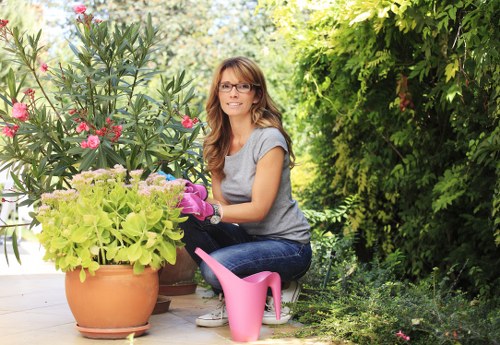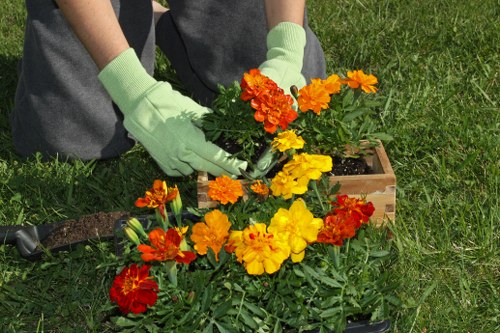Hedge Trimming in Victoria

Hedge trimming is an essential aspect of garden maintenance in Victoria, ensuring that your outdoor spaces remain both aesthetically pleasing and healthy. Whether you have a sprawling estate or a cozy suburban garden, regular trimming keeps your hedges in optimal condition, promoting growth and preventing disease.
Victoria's unique climate, characterized by its diverse weather patterns, necessitates specific trimming techniques to cater to different hedge types. From the lush greenery of the Yarra Valley to the coastal gardens of Geelong, understanding the nuances of hedge maintenance can significantly enhance your garden's appeal.
In this comprehensive guide, we will delve into the best practices for hedge trimming in Victoria, explore the various types of hedges suitable for the region, and provide tips to maintain their health and beauty throughout the year.

Why Hedge Trimming is Important
Regular hedge trimming offers numerous benefits beyond mere appearance. Proper maintenance can:
- Promote Healthy Growth: Trimming encourages new shoots and thicker foliage.
- Prevent Diseases: Removing dead or diseased branches minimizes the risk of infections spreading.
- Enhance Curb Appeal: Well-maintained hedges contribute to the overall beauty of your property.
- Provide Privacy: Maintaining the right shape and density ensures effective privacy barriers.
In Victoria, where gardens are a vital part of many homes, investing time and effort into hedge trimming can significantly improve both the functionality and appearance of your outdoor spaces.

Types of Hedges Suitable for Victoria
Victoria's diverse climate supports a wide range of hedge plants. Choosing the right type of hedge for your garden depends on factors such as sunlight, soil type, and desired height. Here are some popular options:
Boxwood (Buxus sempervirens)
Boxwood is a classic choice for formal hedges. Its dense foliage and ability to retain shape make it ideal for intricate designs and low borders.
Photinia (Photinia x fraseri)
Photinia offers vibrant red new growth, adding a splash of color to your garden. It thrives in well-drained soil and can be easily shaped.
Privet (Ligustrum vulgare)
Privet is a versatile hedge plant, known for its rapid growth and adaptability to different pruning styles. It's perfect for creating tall privacy screens.
Laurel (Prunus laurocerasus)
Laurel hedges are evergreen and robust, providing excellent coverage and requiring minimal maintenance once established.

Best Practices for Hedge Trimming
To achieve the best results, follow these hedge trimming guidelines tailored for Victoria's environment:
- Choose the Right Time: The optimal time for hedge trimming is late winter to early spring, before new growth starts. Avoid trimming during extreme weather conditions.
- Use Sharp Tools: Ensure your shears and pruning tools are sharp to make clean cuts, reducing the risk of damaging the plant.
- Trim Gradually: Avoid removing more than one-third of the hedge's height at a time to prevent stressing the plant.
- Maintain Shape: Regular trimming helps maintain the desired shape and prevents hedges from becoming overgrown.
- Dispose of Clippings: Remove and dispose of trimmings to prevent the spread of pests and diseases.
Implementing these practices ensures that your hedges remain healthy, vibrant, and visually appealing throughout the year.

Seasonal Hedge Trimming Tips
Victoria experiences distinct seasons, each requiring different hedge trimming approaches:
Spring
As plants emerge from dormancy, spring is an excellent time for a thorough trim. This encourages new growth and helps shape the hedge before the summer heat.
Summer
In the warmer months, light trimming can help manage growth and prevent hedges from becoming too dense, ensuring adequate air circulation.
Autumn
Autumn trimming focuses on removing any overgrown sections and preparing the hedge for the winter months, reducing the risk of storm damage.
Winter
Generally, winter is not ideal for heavy trimming. However, removing any damaged or diseased branches can help maintain the hedge's health.

Choosing Professional Hedge Trimming Services in Victoria
While DIY trimming is feasible, hiring professional hedge trimmers offers numerous advantages:
- Expertise: Professionals have the knowledge and experience to handle various hedge types and pruning techniques.
- Time-Saving: Outsourcing the task frees up your time for other gardening activities.
- Proper Equipment: Professionals use specialized tools, ensuring precise and safe trimming.
- Consistent Results: Regular professional maintenance guarantees consistently well-shaped hedges.
When selecting a hedge trimming service in Victoria, consider their reputation, experience, and customer reviews to ensure you receive high-quality service.

Environmentally Friendly Hedge Trimming Practices
Adopting eco-friendly trimming practices contributes to a sustainable garden:
- Use Manual Tools: Whenever possible, use manual shears instead of powered tools to reduce carbon emissions.
- Recycle Green Waste: Compost trimmings or use them as mulch to enrich your garden soil.
- Choose Native Plants: Opt for native hedge species that require less water and are more resistant to local pests.
- Avoid Chemicals: Minimize the use of chemical fertilizers and pesticides to protect the local ecosystem.
Implementing these practices not only benefits the environment but also promotes a healthier and more resilient garden.

Common Hedge Trimming Mistakes to Avoid
Even seasoned gardeners can make mistakes when trimming hedges. Awareness of these common errors can help you maintain your hedges effectively:
- Over-Pruning: Removing too much foliage can stress the plant and inhibit growth.
- Improper Timing: Trimming at the wrong time of year can disrupt the plant's natural growth cycle.
- Using Dull Tools: Dull tools can cause ragged cuts, increasing the risk of disease.
- Ignoring Plant Health: Trimming sick or infested hedges without addressing the underlying issues can worsen the problem.
- Neglecting Regular Maintenance: Infrequent trimming can lead to overgrown and unmanageable hedges.
By avoiding these pitfalls, you can ensure that your hedges remain healthy, attractive, and well-maintained.

Tools and Equipment for Effective Hedge Trimming
Having the right tools is crucial for efficient and safe hedge trimming:
- Pruning Shears: Ideal for small branches and detailed work.
- Hedge Trimmers: Suitable for larger hedges and achieving uniform cuts.
- Loppers: Perfect for cutting thicker branches that shears can't handle.
- Gloves: Protect your hands from thorns and sharp branches.
- Safety Glasses: Shield your eyes from debris and potential hazards.
Investing in quality tools not only makes the trimming process easier but also ensures the health and longevity of your hedges.

Maintaining Trimmed Hedges
Proper maintenance post-trimming is essential to keep your hedges healthy:
- Watering: Ensure your hedges receive adequate water, especially during dry spells.
- Fertilizing: Apply appropriate fertilizers to provide necessary nutrients for growth.
- Pest Control: Regularly inspect for pests and treat infestations promptly.
- Mulching: Apply mulch around the base to retain moisture and suppress weeds.
- Regular Inspections: Periodically check your hedges for signs of disease or damage.
Consistent maintenance routines help your hedges thrive, ensuring they continue to enhance your garden's beauty year after year.

DIY vs. Professional Hedge Trimming
Deciding between DIY and professional hedge trimming depends on several factors:
DIY Trimming
Pros:
- Cost-Effective: Saves money on service fees.
- Flexible Scheduling: You can trim at your convenience.
- Satisfaction: Personal achievement in maintaining your garden.
Cons:
- Time-Consuming: Can take significant time, especially for larger hedges.
- Skill Requirements: Requires knowledge of proper trimming techniques.
- Safety Risks: Potential hazards if using power tools without proper precautions.
Professional Trimming
Pros:
- Expertise: Professionals ensure precise and healthy trims.
- Efficiency: Faster completion of the trimming job.
- Safety: Reduced risk of accidents with trained personnel.
Cons:
- Cost: Higher expense compared to DIY methods.
- Scheduling: Must coordinate with service providers.
Ultimately, the choice depends on your budget, time availability, and comfort level with garden maintenance tasks. For those seeking flawless results and professional care, hiring a hedge trimming service in Victoria is a worthwhile investment.

Innovative Hedge Trimming Techniques
Advancements in gardening have introduced innovative techniques to enhance hedge trimming:
Topiary Art
Topiary involves shaping hedges into intricate designs and sculptures, adding a unique artistic touch to your garden.
Automated Trimming Systems
Some modern systems allow for automated hedge trimming, maintaining consistent shapes without manual effort.
Eco-Friendly Practices
Incorporating sustainable methods, such as using electric trimmers, reduces environmental impact while maintaining your hedges.
Integrated Pest Management
Combining trimming with pest management ensures your hedges remain healthy and free from infestations.
Embracing these techniques can elevate the appearance and health of your hedges, making your garden stand out in Victoria's competitive landscaping scene.

Cost of Hedge Trimming Services in Victoria
The cost of professional hedge trimming in Victoria varies based on several factors:
- Hedge Size: Larger hedges require more time and resources, increasing the cost.
- Density: Denser hedges may need more effort to trim effectively.
- Accessibility: Hard-to-reach areas may require special equipment, impacting the price.
- Additional Services: Services like disposal of trimmings or pest treatments can add to the overall cost.
On average, homeowners can expect to pay between $50 to $150 per hedge, depending on these factors. It's advisable to obtain multiple quotes from reputable service providers to ensure competitive pricing and quality service.

Preparing Your Garden for Hedge Trimming
Proper preparation ensures a smooth and effective trimming process:
- Clear the Area: Remove any debris or obstacles around the hedge to provide ample space for trimming.
- Assess Hedge Health: Inspect for any signs of disease or damage before starting.
- Gather Tools: Ensure all necessary tools are clean, sharp, and in good working condition.
- Create a Plan: Decide on the trimming style and desired shape ahead of time.
- Safety First: Wear appropriate protective gear, including gloves and eye protection.
Following these steps prepares both you and your garden for a successful hedge trimming session.

Aftercare for Trimmed Hedges
Once trimming is complete, proper aftercare is crucial:
- Watering: Provide adequate moisture to help the hedge recover from pruning stress.
- Fertilizing: Apply a balanced fertilizer to promote healthy new growth.
- Monitoring: Keep an eye on the trimmed areas for any signs of pests or diseases.
- Pruning Tools Maintenance: Clean and sanitize your tools to prevent the spread of diseases to other plants.
- Scheduled Trims: Establish a regular trimming schedule to maintain hedge health and appearance.
Effective aftercare ensures your hedges remain robust and continue to enhance your garden's beauty.

Benefits of Regular Hedge Inspection
Regular inspections complement trimming efforts by identifying potential issues early:
Early Disease Detection
Spotting signs of disease early allows for timely intervention, preventing widespread damage.
Pest Management
Identifying pest infestations during inspections ensures effective and targeted treatments.
Structural Integrity
Assessing the structural health of your hedges helps in maintaining their shape and preventing breakage.
Soil Health
Monitoring soil conditions around your hedges ensures they receive adequate nutrients and drainage.
Integrating regular inspections into your garden maintenance routine fosters a healthy and thriving hedge landscape.

Hedge Trimming and Property Value
Well-maintained hedges can significantly impact your property's value:
- First Impressions: Attractive gardens enhance curb appeal, making a positive impression on potential buyers.
- Privacy and Security: Neatly trimmed hedges provide privacy and can act as deterrents for unwanted visitors.
- Landscape Aesthetics: Cohesive and well-shaped hedges contribute to a harmonious and inviting outdoor space.
- Environmental Benefits: Healthy hedges support local wildlife and contribute to a sustainable ecosystem.
Investing in regular hedge trimming is not only beneficial for immediate aesthetic improvements but also adds long-term value to your property.

Hedge Trimming Tips for Beginners
If you're new to hedge trimming, here are some essential tips to get you started:
- Understand Your Hedge Type: Different plants require specific trimming techniques. Research your hedge species before starting.
- Start Small: Begin with minor trims to build confidence and understand the plant's growth patterns.
- Use the Right Tools: Invest in quality trimming tools to ensure clean cuts and ease of use.
- Maintain Consistency: Regular trims help establish a routine and keep your hedge in shape.
- Seek Guidance: Consult gardening resources or professionals if you're unsure about trimming methods.
With practice and patience, you'll become adept at maintaining beautiful hedges that enhance your Victoria garden.

Legal Considerations for Hedge Trimming in Victoria
Before undertaking hedge trimming, it's important to be aware of local regulations:
- Boundary Hedges: If your hedge marks a property boundary, ensure you have the proper permissions or agreements with your neighbor before trimming.
- Height and Density Regulations: Some areas have restrictions on the maximum height and density of hedges, especially near roads and public spaces.
- Protected Species: Certain hedge plants may be protected, requiring special permits for trimming or removal.
- Environmental Laws: Adhere to guidelines that protect local wildlife habitats and ecosystems.
Complying with these regulations ensures responsible gardening practices and fosters good relationships with neighbors and the community.

Enhancing Your Garden with Complementary Plantings
While maintaining hedges, consider integrating other plants to create a cohesive and vibrant garden:
Flowering Shrubs
Planting seasonal flowers alongside your hedges adds color and attracts pollinators, enhancing biodiversity.
Climbing Plants
Vines and climbers can be trained on hedges, adding vertical interest and maximizing garden space.
Herb Gardens
Incorporating herbs near your hedges provides both aesthetic appeal and practical uses for cooking and home remedies.
Ornamental Grasses
Ornamental grasses offer texture and movement, complementing the structure of trimmed hedges.
Strategically selecting complementary plantings enriches your garden's ecosystem and visual appeal, creating a harmonious outdoor environment.

Conclusion
Hedge trimming is a vital component of garden maintenance in Victoria, contributing to the health, beauty, and value of your property. Whether you choose to undertake the task yourself or hire professionals, understanding the best practices, suitable hedge types, and seasonal requirements ensures your hedges thrive year-round.
By implementing the strategies outlined in this guide, you can achieve a well-manicured garden that stands out in Victoria's diverse landscapes. Remember, consistent care and attention are key to maintaining lush, vibrant hedges that enhance your outdoor living spaces.
Contact us today to book your hedge trimming service and transform your garden into a stunning masterpiece.